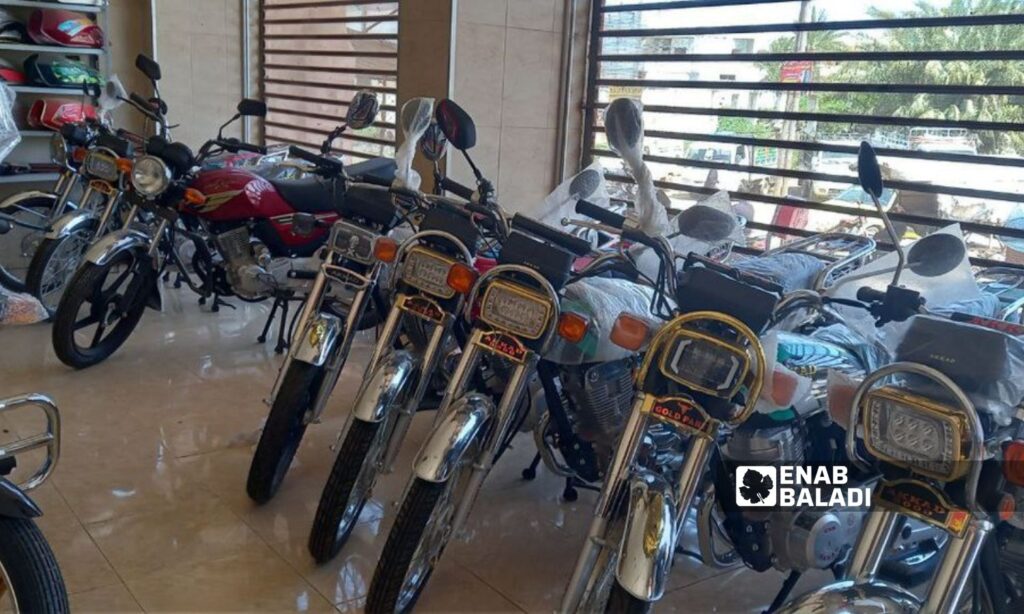Enab Baladi – Halim Muhammad
With the onset of summer, rural areas in Daraa province, southern Syria, are witnessing an increase in demand for purchasing motorcycles.
Motorcycles have become an essential means to meet household needs amid rising gasoline prices and increasing car prices, coupled with the decline in residents’ purchasing power.
These conditions have given motorcycles an advantage over cars due to their lower prices and reduced consumption.
Hisham, a motorcycle seller in western rural Daraa, told Enab Baladi that the local market saw an improvement in motorcycle sales after winter ended.
He added that the price of a motorcycle varies depending on its type, country of manufacture, and engine power.
The price of a new motorcycle differs from that of a used one, with the former being sold for amounts ranging between $800 and $1,200, while the used ones do not exceed $700.
For commercial purposes
The motorcycle is no longer just a small vehicle for two people but has become a means relied upon by small business owners to obtain their store supplies amid rising transport fares.
Abdul Hamid Kiwan (45 years old) bought a small cart that can carry approximately 300 kilograms and attached it to his motorcycle, using it to transport groceries to his store in western rural Daraa.
Kiwan resorted to this method after transport fares surged, as renting a private car costs no less than 150,000 Syrian pounds.
It has become common to see carts pulled by motorcycles, a newly invented tool made by blacksmiths and attached to the back of motorcycles.
Kiwan told Enab Baladi that a car is a better means to carry goods, but he cannot afford to buy a private car, as no car costs less than $7,000.
The cost of car repairs has also increased, forcing him to rely on his motorcycle to fetch his goods.
For Nasser Mohammed, a young man, the motorcycle has also become the primary means to meet his household needs, carrying herbs and fodder for his livestock on the cart. Mohammed owns two cows and 15 sheep.
He carries drinking water to his home after the public water supply was cut off in the town, relying on well water located three kilometers away.
He said the ideal solution for him would be to buy a tractor or a farm vehicle, but he cannot afford one, so he bought a motorcycle and a cart to help him meet his needs.
The market also has smuggled motorcycles coming through Lebanon, priced $100 to $200 less than legally imported motorcycles, but these do not get subsidized gasoline allocations and are subject to confiscation if caught by traffic patrols.
Mohammed al-Ali (45 years old) sold his car and bought a motorcycle because he could not afford to buy gasoline from the local market, where the price per liter of gasoline reached 25,000 Syrian pounds. The subsidized gasoline allocation for his car did not meet his transportation needs.
Al-Ali said the car is better for the family as it carries all five members and provides shelter from the summer heat and winter cold, but it consumes large amounts of gasoline, exceeding his financial capabilities.
Greater danger
Despite its importance to the residents, the motorcycle is more prone to accidents due to its two-wheel design, and it can be recklessly used by adolescents at high speeds and for drifting, leading to death or severe injuries.
Last February, a child named Hamza al-Rawashdeh died in Tafas due to excessive speed.
Enab Baladi documented dozens of motorcycle accidents in western rural Daraa since the beginning of this year.
Another risk posed by motorcycles is their use in assassinations, as they are commonly employed in such operations.
Daraa province is experiencing a state of chaos and lawlessness, with the Daraa Martyrs Documentation Office recording 74 assassination attempts and operations last April, resulting in the death of 54 people.
In July 2022, the governor of Daraa, Louay Kharita, issued a decision allowing the registration of undocumented motorcycles with the Transport Directorate, which opened centers in the cities of Daraa, Nawa, al-Sanamayn, Izra, and Busra al-Sham. After verifying the number engraved on the motorcycle’s engine, the vehicle is registered with the Transport Directorate, and a digital plate and electronic card are issued, enabling the owner to receive their allocation of subsidized gasoline.

